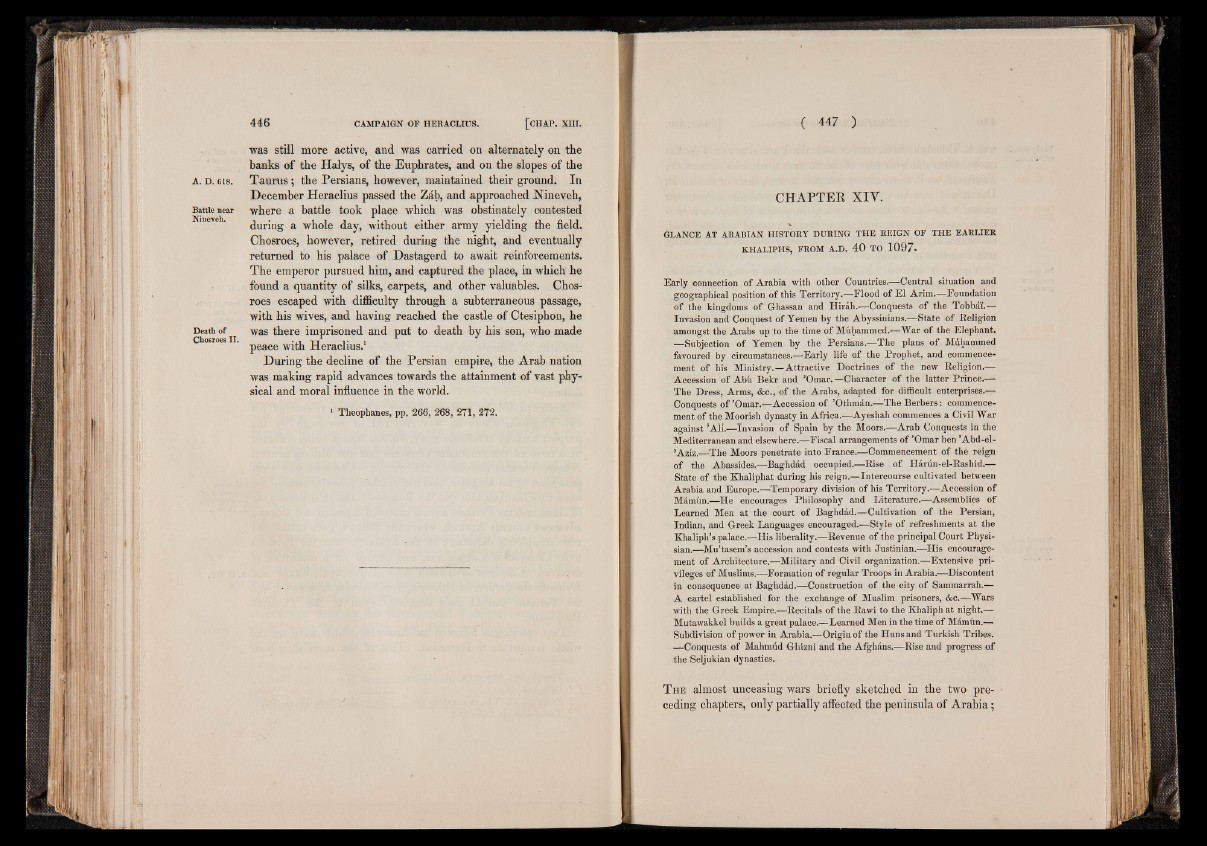
Battle near
Nineveh.
Death of
Chosroes II.
was still more active, and was carried on alternately on the
banks of the Halys, of the Euphrates, and on the slopes of the
Taurus; the Persians, however, maintained their ground. In
December Heraclius passed the Zab, and approached Nineveh,
where a battle took place which was obstinately contested
during a whole day, without either army yielding the field.
Chosroes, however, retired during the night, and eventually
returned to his palace of Dastagerd to await reinforcements.
The emperor pursued him, and captured the place, in which he
found a quantity of silks, carpets, and other valuables. Chosroes
eseaped with difficulty through a subterraneous passage,
with his wives, and having reaehed the castle of Ctesiphon, he
was there imprisoned and put to death by his son, who made
peace with Heraclius.1: r
During the decline of the Persian empire, the Arab nation
was making rapid advances towards the attainment of vast physical
and moral influence in the world.
1 Theophanes, pp. 266, 268, 271, 2T2.
CHAPTER XIV.
\
GLANCE AT ARABIAN HISTORY DURING THE REIGN OF THE EARLIER
KHALIPHS, FROM A.D. 40 TO 1097-
Early connection of Arabia with other Countries.—Central situation and
geographical position of this Territory.-—Flood of E l Arim.—Foundation
o f the kingdoms of Ghassan and Hirah.-—Conquests of the Tobba'i.—
Invasion and Conquest of Yemen by the Abyssinians.—State o f Religion
amongst the Arabs up to the time of Muhammed.—War of the Elephant.
—Subjection of Yemen by the Persians.—The plans of Muhammed
favoured by circumstances.—Early life of the Prophet, and commencement
of his Ministry.—Attractive Doctrines of the new Religion.—
Accession of Abû Bekr and ’Omar.—Character of the latter Prince.—
The Dress, Arms, &c., of the Arabs, adapted for difficult enterprises.—
Conquests of ’Omar.—Accession of ’Othmân.—The Berbers : commencement
o f the Moorish dynasty in Africa.—Ayeshah commences a Civil W ar
against ’AH.—Invasion of Spain by the Moors.—Arab Conquests in the
Mediterranean and elsewhere.—Fiscal arrangements of ’Omar ben ’Abd-el-
’Azfz.—The Moors penetrate into France.—Commencement of the reign
of the Abassides.—Baghdad occupied.—Rise of Hârûn-el-Rashid.—
State of the Khaliphat during his reign.—Intercourse cultivated between
Arabia and Europe.—Temporary division of his Territory.—Accession o f
Mâmûn.—He encourages Philosophy and Literature.—Assemblies of
Learned Men at the court of Baghdad.—Cultivation of the Persian,
Indian, and Greek Languages encouraged.—Style of refreshments at the
Khaliph’s palace.—His liberality.BRevenue of the principal Court Physi-
sian.—Mu’tasem’s accession and contests with Justinian.—His encouragement
of Architecture.—Military and Civil organization.—Extensive privileges
of Muslims.—Formation of regular Troops in Arabia.—Discontent
in consequence at Baghdad.—Construction of the city of Sammarrah.—
A cartel established for the exchange of Muslim prisoners, &c.—Wars
with the Greek Empire.—Recitals of the Rawi to the Khaliph at night.—
Mutawaklel builds a great palace.—Learned Men in the time of Mâmûn.—
Subdivision of power in Arabia.—Origin of the Huns and Turkish Tribes.
—Conquests o f Mahmud Ghizni and the Afghans.—Rise and progress o f
the Seljukian dynasties.
T h e almost unceasing wars briefly sketched in the two preceding
chapters, only partially affected the peninsula of Arabia;